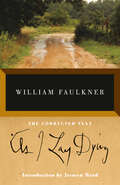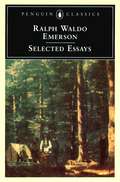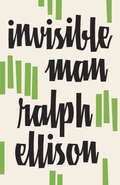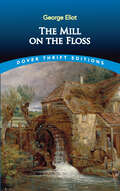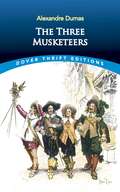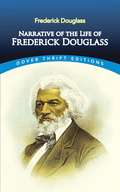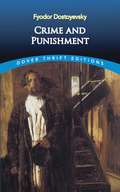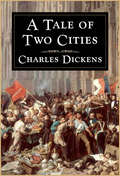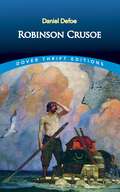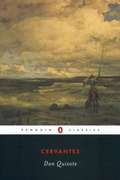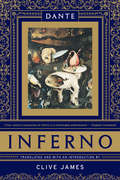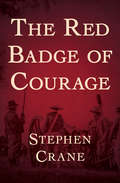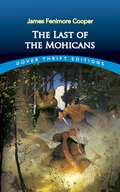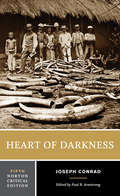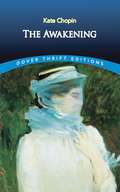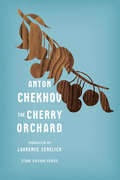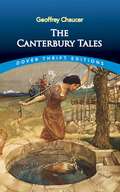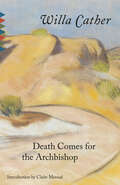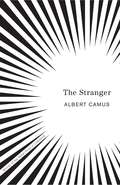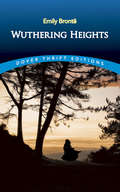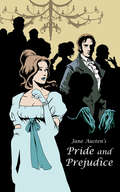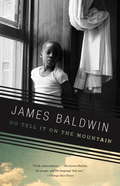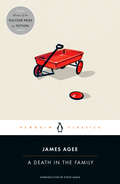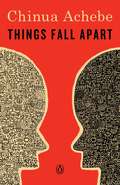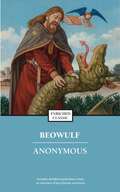Special Collections
College Board's 100 Books for College-Bound Readers
- Table View
- List View
As I Lay Dying
by William FaulknerA true 20th-century classic from the Nobel Prize-winning author of The Sound and the Fury: the famed harrowing account of the Bundren family&’s odyssey across the Mississippi countryside to bury Addie, their wife and mother. As I Lay Dying is one of the most influential novels in American fiction in structure, style, and drama. Narrated in turn by each of the family members, including Addie herself as well as others, the novel ranges in mood from dark comedy to the deepest pathos. &“I set out deliberately to write a tour-de-force. Before I ever put pen to paper and set down the first word I knew what the last word would be and almost where the last period would fall.&” —William Faulkner on As I Lay Dying This edition reproduces the corrected text of As I Lay Dying as established in 1985 by Noel Polk.
Selected Essays
by Ralph Waldo EmersonContains a selection from the essays Johnson published twice weekly as The Rambler in the early 1750s.
It was here that he first created the literary character and forged the distinctive prose style that established him as a public figure.
This volume also includes Johnson's essays from the periodicals The Adventurer and The Idler.
Invisible Man
by Ralph EllisonInvisible Man is a milestone in American literature, a book that has continued to engage readers since its appearance in 1952.
The nameless narrator of the novel describes growing up in a black community in the South, attending a Negro college from which he is expelled, moving to New York and becoming the chief spokesman of the Harlem branch of "the Brotherhood", and retreating amid violence and confusion to the basement lair of the Invisible Man he imagines himself to be.
The book is a passionate and witty tour de force of style, strongly influenced by T.S. Eliot's The Waste Land, Joyce, and Dostoevsky.
Winner of the National Book Award
The Mill on the Floss
by George EliotMisunderstood Maggie Tulliver is torn. Her rebellious and passionate nature demands expression, while her provincial kin and community expect self-denial.
Based closely on the author's own life, Maggie's story explores the conflicts of love and loyalty and the friction between desire and moral responsibility.
Written in 1860, The Mill on the Floss was published to instant popularity.
An accurate, evocative depiction of English rural life, this compelling narrative features a vivid and realistic cast, headed by one of 19th-century literature's most appealing characters.
Required reading for most students, it ranks prominently among the great Victorian novels.
The Three Musketeers
by Alexandre DumasWith its rousing cry of "One for all, and all for one," Alexandre Dumas's thrilling adventure novel has captivated generations of readers since its initial publication in 1844. Action, intrigue, and romance abound in this swashbuckling epic, which traces a country lad's path to the French court of the early 1600s and the glorious fraternity of the king's men, the Musketeers.A son of impoverished nobility, D'Artagnan arrives in Paris to find the Musketeers disbanded by the cunning Cardinal Richelieu, who hopes to seize power from the weak-willed Louis XIII. The daring and ambitious youth proves his mettle in the company of the famous Musketeers — Porthos, Athos, and Aramis — and joins them in a heroic struggle to defend the king and his lovely queen, Anne of Austria.Dumas transformed the concept of the historical novel by writing in a modern, conversational style. His accessible, fast-paced narratives combine real and fictional characters to recapture the events, manners, and mood of seventeenth-century France. Emerging in the chaotic aftermath of the Revolution, Dumas's novels provided his contemporaries with a welcome sense of identity and national pride. His most popular work, The Three Musketeers, continues to charm modern readers with its timeless tales of romantic valor.
Narrative of the Life of Frederick Douglass
by Frederick DouglassFormer slave, impassioned abolitionist, brilliant writer, newspaper editor and eloquent orator whose speeches fired the abolitionist cause, Frederick Douglass (1818–1895) led an astounding life. Physical abuse, deprivation and tragedy plagued his early years, yet through sheer force of character he was able to overcome these obstacles to become a leading spokesman for his people.In this, the first and most frequently read of his three autobiographies, Douglass provides graphic descriptions of his childhood and horrifying experiences as a slave as well as a harrowing record of his dramatic escape to the North and eventual freedom.Published in 1845 to quell doubts about his origins — since few slaves of that period could write — the Narrative is admired today for its extraordinary passion, sensitive and vivid descriptions and storytelling power. It belongs in the library of anyone interested in African-American history and the life of one of the country's most courageous and influential champions of civil rights.
Crime and Punishment
by Fyodor Dostoyevsky and Constance GarnettThe two years before he wrote Crime and Punishment (1866) had been bad ones for Dostoyevsky.
His wife and brother had died; the magazine he and his brother had started, Epoch, collapsed under its load of debt; and he was threatened with debtor's prison.
With an advance that he managed to wangle for an unwritten novel, he fled to Wiesbaden, hoping to win enough at the roulette table to get himself out of debt.
Instead, he lost all his money; he had to pawn his clothes and beg friends for loans to pay his hotel bill and get back to Russia.
One of his begging letters went to a magazine editor, asking for an advance on yet another unwritten novel -- which he described as Crime and Punishment.
One of the supreme masterpieces of world literature, Crime and Punishment catapulted Dostoyevsky to the forefront of Russian writers and into the ranks of the world's greatest novelists.
Drawing upon experiences from his own prison days, the author recounts in feverish, compelling tones the story of Raskolnikov, an impoverished student tormented by his own nihilism, and the struggle between good and evil.
Believing that he is above the law, and convinced that humanitarian ends justify vile means, he brutally murders an old woman -- a pawnbroker whom he regards as "stupid, ailing, greedy...good for nothing."
Overwhelmed afterwards by feelings of guilt and terror, Raskolnikov confesses to the crime and goes to prison.
There he realizes that happiness and redemption can only be achieved through suffering.
Infused with forceful religious, social, and philosophical elements, the novel was an immediate success. This extraordinary, unforgettable work is reprinted here in the authoritative Constance Garnett translation.
A selection of the Common Core State Standards Initiative.
A Tale of Two Cities
by Charles DickensA Tale of Two Cities (1859) is a novel by Charles Dickens, set in London and Paris before and during the French Revolution.
The novel tells the story of the French Doctor Manette, his 18-year-long imprisonment in the Bastille in Paris and his release to life in London with his daughter Lucie, whom he had never met; Lucie's marriage and the collision between her beloved husband and the people who caused her father's imprisonment; and Monsieur and Madame Defarge, sellers of wine in a poor suburb of Paris.
The story is set against the conditions that led up to the French Revolution and the Reign of Terror.
Robinson Crusoe
by Daniel DefoeThought to have been inspired by the true-life experiences of a marooned sailor, Robinson Crusoe tells the story of the sole survivor of a shipwreck, stranded on a Caribbean island, who prevails against all odds, enduring three decades of solitude while mastering both himself and his strange new world. First published in 1719, the novel has long been one of the English language's great adventure stories.In the journal he shares with us, the endearing, goatskin-clad castaway recounts the details of his lonely existence and his many adventures, including a fierce battle with cannibals and a daring rescue of Friday, the man who becomes his trusted servant and companion. Defoe's brilliant and imaginative use of detail renders Crusoe's island world utterly convincing. In reclaiming his humanity from the savagery of his circumstances, the hero humbly acquires the qualities of courage, patience, ingenuity, and industry.Hailed as the first great English novel, Robinson Crusoe spawned legions of imitations, none of which surpass the original. All readers with a taste for adventure will relish this inexpensive edition of one of the most popular and influential books ever written.
Don Quixote
by Miguel de Cervantes Saavedra and Roberto Gonzalez Echevarria and John RutherfordDon Quixote has become so entranced reading tales of chivalry that he decides to turn knight errant himself. In the company of his faithful squire, Sancho Panza, these exploits blossom in all sorts of wonderful ways.
While Quixote's fancy often leads him astray--he tilts at windmills, imagining them to be giants--Sancho acquires cunning and a certain sagacity.
Sane madman and wise fool, they roam the world together-and together they have haunted readers' imaginations for nearly four hundred years.
With its experimental form and literary playfulness, Don Quixote has been generally recognized as the first modern novel.
This Penguin Classics edition, with its beautiful new cover design, includes John Rutherford's masterly translation, which does full justice to the energy and wit of Cervantes's prose, as well as a brilliant critical introduction by Roberto Gonzalez Echevarriá.
Inferno
by Dante Alighieri and Clive JamesDante's immortal vision of Hell shines "as it never did before in English verse" (Edward Mendelson) in Clive James's new translation of Inferno.
The most captivating part of perhaps the greatest epic poem ever written, Dante's Inferno still holds the power to thrill and inspire.
The medieval equivalent of a thriller, Inferno follows Dante and his faithful guide, Virgil, as they traverse the complex geography of Hell, confronting its many threats, macabre punishments, and historical figures, before reaching the deep chamber where Satan himself resides.
Now, in this new translation, Clive James communicates not just the transcendent poetry of Dante's language but also the excitement and terror of his journey through the underworld.
Instead of Dante's original terza rima, a form which in English tends to show the strain of composition, James employs fluently linked quatrains, thereby conveying the seamless flow of Dante's poetry and the headlong momentum of the action.
As James writes in his introduction, Dante's great poem "can still astonish us, whether we believe in the supernatural or not. At the very least it will make us believe in poetry."
The Red Badge of Courage
by Stephen CraneThe finest novel of the Civil War, and one of the greatest battle stories ever toldThe question of courage enters Henry Fleming&’s mind the moment he dons the blue uniform of the Union Army. But his first firefight reveals the emptiness of words such as bravery and fear. Pinned in by his comrades, he can only fire his rifle like a cog in a machine. There is no chance to run.Then comes the true test. Waking from a nap, Henry sees the enemy advancing once again. Gripped by an unshakable terror, he flees—from his regiment, from duty, from everything he wanted to believe about himself. A corpse bears witness to his shame.The nightmare has come true. Henry Fleming is a coward. Only one thing can save him now: a visible wound, the red badge of courage. With his regiment&’s colors in hand, Henry looks the enemy in the eye—and charges.Stephen Crane was born six years after Lee&’s surrender at Appomattox and had yet to see a battlefield when he wrote The Red Badge of Courage. Nevertheless, the novel is widely regarded as one of the most realistic depictions of war ever published, and a masterpiece of American literature.This ebook has been professionally proofread to ensure accuracy and readability on all devices.
The Last of the Mohicans
by James Fenimore CooperA massacre at a colonial garrison, the kidnapping of two pioneer sisters by Iroquois tribesmen, the treachery of a renegade brave, and the ambush of innocent settlers create an unforgettable, spine-tingling picture of American frontier life in this classic 18th-century adventure -- the most popular of James Fenimore Cooper's Leatherstocking Tales.
First published in 1826, the story -- set in the forests of upper New York State during the French and Indian War -- movingly portrays the relationship between Hawkeye, a gallant, courageous woodsman, and his loyal Mohican friends, Chingachgook and Uncas.
Embroiled in one of the war's bloody battles, they attempt to lead the abducted Munro sisters to safety but find themselves instead in the midst of a final, tragic confrontation between rival war parties.
Imaginative and innovative, The Last of the Mohicans quickly became the most widely read work of the day, solidifying the popularity of America's first successful novelist in the United States and Europe.
Required reading in many American literature classics, the novel presents a stirring picture of a vanishing people and the end to a way of life in the eastern forests.
Heart of Darkness
by Joseph ConradThis Norton Critical Edition includes:- A newly edited text based on the first English book edition (1902), the last version to which Conrad is known to have actively contributed.
"Textual History and Editing Principles" provides an overview of the textual controversies and ambiguities perpetually surrounding Heart of Darkness.
- Background and source materials on colonialism and the Congo, nineteenth-century attitudes toward race, Conrad in the Congo, and Conrad on art and literature.
- Fifteen illustrations. - Seven contemporary responses to the novella along with eighteen essays in criticism--ten of them new to the Fifth Edition,including an entirely new subsection on film adaptations of Heart of Darkness.
- A Chronology and an updated Selected Bibliography.
The Awakening
by Kate ChopinWhen first published in 1899, The Awakening shocked readers with its honest treatment of female marital infidelity.
Audiences accustomed to the pieties of late Victorian romantic fiction were taken aback by Chopin's daring portrayal of a woman trapped in a stifling marriage, who seeks and finds passionate physical love outside the straitened confines of her domestic situation.
Aside from its unusually frank treatment of a then-controversial subject, the novel is widely admired today for its literary qualities. Edmund Wilson characterized it as a work "quite uninhibited and beautifully written, which anticipates D. H. Lawrence in its treatment of infidelity."
Although the theme of marital infidelity no longer shocks, few novels have plumbed the psychology of a woman involved in an illicit relationship with the perception, artistry, and honesty that Kate Chopin brought to The Awakening.
Now available in this inexpensive edition, it offers a powerful and provocative reading experience to modern readers.
The Cherry Orchard
by Anton Chekhov and Laurence SenelickAnton Chekhov is a unique force in modern drama, his works cherished for their brilliant wit and insight into the human condition.
In this stunning new translation of one of Chekhov's most popular and beloved plays, Laurence Senelick presents a fresh perspective on the master playwright and his groundbreaking dramas.
He brings this timeless trial of art and love to life as memorable characters have clashing desires and lose balance in the shifting eruptions of society and a modernizing Russia.
Supplementing the play is an account of Chekhov's life; a note on the translation; an introduction to the work; and variant lines, often removed due to government censorship, which illuminate the context in which they were written.
This edition is the perfect guide to enriching our understanding of this great dramatist or to staging a production.
The Canterbury Tales
by Geoffrey ChaucerA group of pilgrims bound for Canterbury Cathedral agree to pass the weary miles by taking turns at storytelling.
The travelers - noble, coarse, jolly, and pious - offer a vibrant portrait of fourteenth-century English life.
Their narratives form English literature's greatest collection of chivalric romances, bawdy tales, fables, legends, and other stories.
The Canterbury Tales reflects a society in transition, as a middle class began to emerge from England's feudal system.
Craftsmen and laborers ride side by side with the gentry on the road to the shrine of St. Thomas à Becket, and their discussions and arguments about ethical issues mirror their changing world.
The pilgrims' conversations and stories also reveal their individual personalities, and Chaucer's vivid, realistic characterizations assured the Tales an instant and enduring success.
Each pilgrim's story can be read separately and appreciated in its own right; all appear here in a lucid translation into modern English verse by J. U. Nicolson.
Death Comes for the Archbishop
by Willa CatherWilla Cather's best known novel is an epic—almost mythic—story of a single human life lived simply in the silence of the southwestern desert. In 1851 Father Jean Marie Latour comes to serve as the Apostolic Vicar to New Mexico. What he finds is a vast territory of red hills and tortuous arroyos, American by law but Mexican and Indian in custom and belief. In the almost forty years that follow, Latour spreads his faith in the only way he knows--gently, all the while contending with an unforgiving landscape, derelict and sometimes openly rebellious priests, and his own loneliness. Out of these events, Cather gives us an indelible vision of life unfolding in a place where time itself seems suspended.BONUS: The edition includes an excerpt from The Selected Letters of Willa Cather.
The Stranger
by Albert CamusThrough the story of an ordinary man unwittingly drawn into a senseless murder on an Algerian beach, Camus explored what he termed "the nakedness of man faced with the absurd."
Wuthering Heights
by Emily BrontëConsidered lurid and shocking by mid-19th-century standards, Wuthering Heights was initially thought to be such a publishing risk that its author, Emily Brontë, was asked to pay some of the publication costs.
A somber tale of consuming passions and vengeance played out against the lonely moors of northern England, the book proved to be one of the most enduring classics of English literature.
The turbulent and tempestuous love story of Cathy and Heathcliff spans two generations -- from the time Heathcliff, a strange, coarse young boy, is brought to live on the Earnshaws' windswept estate, through Cathy's marriage to Edgar Linton and Heathcliff's plans for revenge, to Cathy's death years later and the eventual union of the surviving Earnshaw and Linton heirs.
A masterpiece of imaginative fiction, Wuthering Heights (the author's only novel) remains as poignant and compelling today as it was when first published in 1847.
Pride and Prejudice
by Jane AustenElizabeth Bennet, one of Austen's most enduring heroines, has four sisters, a mother desperate to find them all good marriages, and not much family wealth.
When Elizabeth meets the handsome and rich Mr. Darcy, it is not love at first sight.
But there's more to Darcy than just pride as Elizabeth grows to realize.
A charming and timeless romance and comedy of manners and morality, Pride and Prejudice is eminently rereadable.
Go Tell It on the Mountain
by James Baldwin"Mountain," Baldwin said, "is the book I had to write if I was ever going to write anything else."
Go Tell It On The Mountain, first published in 1953, is Baldwin's first major work, a novel that has established itself as an American classic.
With lyrical precision, psychological directness, resonating symbolic power, and a rage that is at once unrelenting and compassionate, Baldwin chronicles a fourteen-year-old boy's discovery of the terms of his identity as the stepson of the minister of a storefront Pentecostal church in Harlem one Saturday in March of 1935.
Baldwin's rendering of his protagonist's spiritual, sexual, and moral struggle of self-invention opened new possibilities in the American language and in the way Americans understand themselves.
A Death in the Family
by James Agee and Steve EarlePublished in 1957, two years after its author's death at the age of forty-five, A Death in the Family remains a near-perfect work of art, an autobiographical novel that contains one of the most evocative depictions of loss and grief ever written.
As Jay Follet hurries back to his home in Knoxville, Tennessee, he is killed in a car accident-a tragedy that destroys not only a life, but also the domestic happiness and contentment of a young family.
A novel of great courage, lyric force, and powerful emotion, A Death in the Family is a masterpiece of American literature.
Pulitzer Prize Winner
Things Fall Apart
by Chinua AchebeTHINGS FALL APART tells two overlapping, intertwining stories, both of which center around Okonkwo, a "strong man" of an Ibo village in Nigeria.
The first of these stories traces Okonkwo's fall from grace with the tribal world in which he lives, and in its classical purity of line and economical beauty it provides us with a powerful fable about the immemorial conflict between the individual and society.
The second story, which is as modern as the first is ancient, and which elevates the book to a tragic plane, concerns the clash of cultures and the destruction of Okonkwo's world through the arrival of aggressive, proselytizing European missionaries.
These twin dramas are perfectly harmonized, and they are modulated by an awareness capable of encompassing at once the life of nature, human history, and the mysterious compulsions of the soul.
THINGS FALL APART is the most illuminating and permanent monument we have to the modern African experience as seen from within.
[This text is listed as an example that meets Common Core Standards in English language arts in grades 9-10 at http://www.corestandards.org.]
Beowulf
by AnonymousThe story of one man's triumph over a legendary monster, Beowulf marks the beginning of Anglo-Saxon literature as we know it today.
This Enriched Classic includes:
• A concise introduction that gives readers important background information
• A timeline of significant events that provides the book's historical context
• An outline of key themes and plot points to help readers form their own interpretations
• Detailed explanatory notes
• Critical analysis and modern perspectives on the work
• Discussion questions to promote lively classroom and book group interaction
•
A list of recommended related books and films to broaden the reader's experience Enriched Classics offer readers affordable editions of great works of literature enhanced by helpful notes and insightful commentary.
The scholarship provided in Enriched Classics enables readers to appreciate, understand, and enjoy the world's finest books to their full potential. Series edited by Cynthia Brantley Johnson
